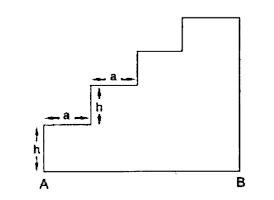Figureshows a number of equal steps. If the 'rise' of each step is h cm, are there are n steps, make a formula for the height (H) in centrimeters of the steps.

H=12nH
H=2nh
H=nh
H=n2h
The correct Answer is:C
Step by step video, text & image solution for Figureshows a number of equal steps. If the 'rise' of each step is h cm, are there are n steps, make a formula for the height (H) in centrimeters of the steps. by Maths experts to help you in doubts & scoring excellent marks in Class 7 exams.
Related Playlists
- BOOK - S CHAND IIT JEE FOUNDATIONCHAPTER - ALGEBRAIC EXPRESSIONS EXERCISE - SELF ASSESSMENT SHEET-71videos
ALGEBRAIC EXPRESSIONS
- BOOK - S CHAND IIT JEE FOUNDATIONCHAPTER - ALGEBRAIC EXPRESSIONS EXERCISE - SELF ASSESSMENT SHEET-81videos
ALGEBRAIC EXPRESSIONS
- BOOK - S CHAND IIT JEE FOUNDATIONCHAPTER - ALGEBRAIC EXPRESSIONS EXERCISE - SELF ASSESSMENT SHEET-171videos
ALGEBRAIC EXPRESSIONS
- BOOK - S CHAND IIT JEE FOUNDATIONCHAPTER - ALGEBRIC IDENTITIESEXERCISE - Self Assessment Sheet-710videos
ALGEBRIC IDENTITIES
Similar Practice Problems
- Question 1 - Select One
If the 'tread' of each step is a cm, and there are n steps, make a formula for the length (d cm) of AB.
 Ad=12naBd=naCd=3naDd=na2
Ad=12naBd=naCd=3naDd=na2 - Question 1 - Select One
The formula for the step deviation method of finding the mean is-
A¯¯¯X=∑xNB¯¯¯X=A+∑dxNC¯¯¯X=A+∑dxNXID¯¯¯X=∑fx∑f - Question 1 - Select One
A ball is bouncing down a set of stairs. The coefficient of restitution is e. The height of each step is d and the ball bounces one step at each bounce. After each bounce the ball rebounds to a height h above the next lower step. Neglect width of each step in comparison to h and assume the impacts to be effectively head on. Which of the following relative is correct ?
Ahd=1−e2Bhd=1−eChd=11−e2Dhd=11−e - Question 1 - Select One
In following algorithm x,y and z are variables which change their values in each step such that the value of the expression on the right hand side is assigned to the variable on the left hand side of the equation. Each cycle consists of 5 steps. S1,S2,S3,....are the sum of each corresponding cycle 1,2,3...
START
Step 0. x=1, y=-2, z=3
Step 1. x=y-z
Step 2. y=z-x
Step 3. z=x-y
Step 4. S=x+y+z
Step 5. Go to step 1.
Which one of the following is correct for each cycle?AS=2xBS=3xCS is an odd numberDnone of these - Question 1 - Select One
In the following algorithm x, y and z are variables which change their values in each step such that the value of the expression on the right hand side is assigned to the variable on the left hand side of the equation. Each cycle consists of 5 steps, S1,S2,S3.... are the sum of each corresponding cycle 1, 2, 3.......
START
Step 0. x=1,y=−2,z=3
Step 1. x=y−z
Step 2. y=z−x
Step 3. z=x−y
Step 4. S=x+y+z
Step 5. Go to step 1.
Which one of the following is correct for each cycle?AS=2xBS=3xCS is an odd numberDnone of these - Question 1 - Select One
In the following algorithm x, y and z are variables which change their values in each step such that the value of the expression on the right hand side is assigned to the variable on the left hand side of the equation. Each cycle consists of 5 steps, S1,S2,S3.... are the sum of each corresponding cycle 1, 2, 3.......
START
Step 0. x=1,y=−2,z=3
Step 1. x=y−z
Step 2. y=z−x
Step 3. z=x−y
Step 4. S=x+y+z
Step 5. Go to step 1.
What is the value of S4?A987B754C−178Dnone of these
Similar Questions
Three friends Riya, Mini and Trisha are going up a flight of stairs. Riya is at step x, Mini is four steps ahead of Riya and Trisha is three steps behind Riya.
If the total number of steps is 5 less than three times the number of steps climbed by Riya, find to the total number of steps in terms of x.View SolutionA policeman starts to chase a theif .when the thief goes 10 steps the policeman moves 8 steps and 5 steps of the policeman are equal to 7 steps of the theif .the ratio of the speeds of the policeman and the thief is :
View SolutionA person of mass 40 kg picked up a bag of mangoes and climbed ten steps . If the bag contains ten mangoes , each of mass 0.5 kg and the height of each step is 10 cm , then find the work done by the person in carrying that till tenth step (Take g = 10ms−2).
View SolutionA person of mass 40 kg picked up a bag of mangoes and climbed ten steps . If the bag contains ten mangoes , each of mass 0.5 kg and the height of each step is 10 cm , then find the work done by the person in carrying that till tenth step (Take g = 10ms−2).
View Solution

